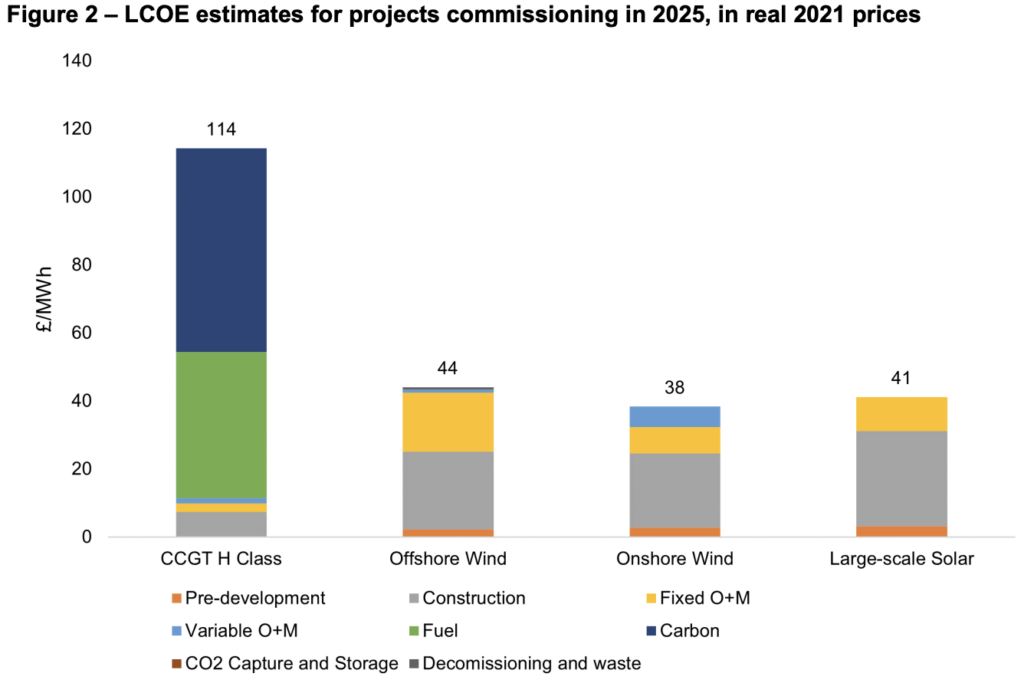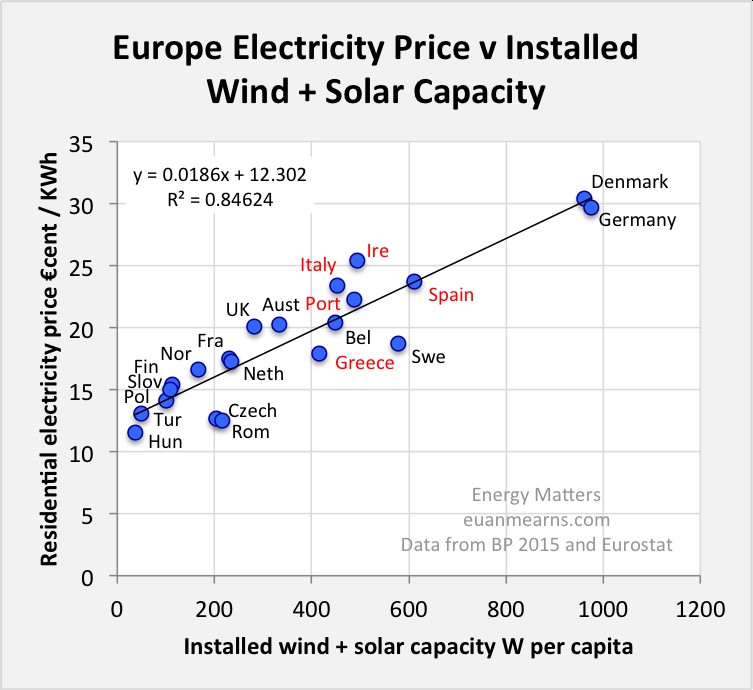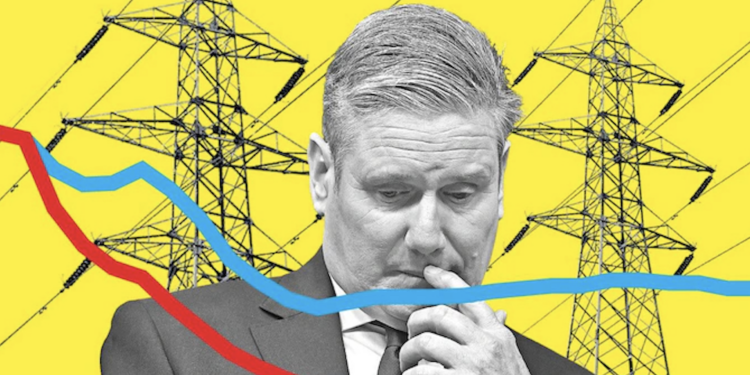Over the next few weeks of the election campaign, we’re going to be swamped with a veritable tsunami of blatant lies and empty promises by our would-be political leaders. Just one of these is Keir Starmer’s claim in the Labour Party manifesto that his new ‘GB Energy’ will lower people’s energy bills by providing cheap, clean energy:
The Labour Party will create Great British Energy, a new, publicly-owned clean energy company. We will harness Britain’s sun, wind and wave energy to save £93 billion for UK households.
This is, of course, complete nonsense, as intermittent and unreliable supposedly ‘renewable energy’, such as wind and solar, is much more expensive than cheap, reliable fossil fuel energy. For example, wholesale electricity prices are currently £65 per megawatt (MW) – about half from fossil fuels and the rest from renewables including wind, solar, hydro and nuclear. But we are paying £102/MW for fixed offshore wind, offering £246/MW to operators for floating offshore wind, £89/MW for onshore wind, and £85/MW for solar.
Being a lawyer rather than a mathematician, Keir Starmer doesn’t seem to have noticed that renewable energy costs of £102/MW for fixed offshore wind, £246/MW for floating offshore wind, £89/MW for onshore wind and £85/MW for solar are rather higher than the current wholesale energy cost of just £65/MW. Given that wind and solar are clearly more expensive than our current energy, you might be tempted to wonder how Starmer can claim that moving to more renewable energy like wind and solar will lower our energy bills? Here’s possibly one reason why Starmer and the herds of Net Zero fanatics keep insisting that renewables are cheaper than fossil fuels.
There’s a Government report titled ‘Electricity Generating Costs 2023’. It concludes that electricity produced by gas costs £114/MegaWatthour (MWh) while offshore wind only costs £44/MWh, onshore wind just £38/MWh and large-scale solar a mere £41/MWh.

So, according to our Government, it’s obvious that cheap, reliable gas is much more expensive than expensive, unreliable renewables, which need cheap, reliable gas as back-up for those times when the wind doesn’t blow and/or the sun doesn’t shine. Confused? You should be.
At the risk of boring you with more numbers, here’s how our Government manages to achieve this mathematical miracle of making cheap, reliable gas power look expensive, and making expensive, unreliable renewables look cheap.
The Government’s first trick is to load energy from gas power stations with a supposed ‘carbon cost’ of £60/MWh. This ‘carbon cost’ is some kind of calculation which takes account of the amount of CO2 released when gas is burned to produce electricity. I’ve no idea where this supposed ‘carbon cost’ comes from or how it is calculated. But if we subtract it from the £114/MWh cost of gas energy production, that brings the production of energy from gas down to £54/MWh. That’s still above the Government’s claimed costs for wind and solar. That brings us to the Government’s next trick – hugely exaggerate the output from wind and possibly solar.
Onshore wind will (according to Professor Google) typically generate about 24% of the theoretical maximum output – what’s often referred to as ‘the nameplate capacity’ or ‘installed capacity’. Yet our Government bases its cost estimates on an output of 45% to 48% – almost twice what is currently achieved. This, of course, hugely reduces the supposed cost of onshore wind. Offshore wind typically generates around 41% of its theoretical maximum capacity. Yet our Government bases its cost estimates on an output of 61% to 69% – around one and a half times what is currently produced. As for solar, our Government bases its costs on a seemingly more realistic output of just 11%. I haven’t been able to find out the typical output of a U.K.-based solar farm. But I do remember the chief executive of one of Germany’s largest power companies explaining that trying to generate solar power in Northern Europe was like trying to grow pineapples in Alaska. I can’t recall seeing any ‘Grown in Alaska’ pineapples in my local supermarket recently. Moreover, if our Government believes that U.K. solar farms only generate 11% of their nameplate capacity, it seems rather pointless to take productive agricultural land away from food production in order to build unproductive solar farms.
A study of the relationship between the level of renewables (wind and solar only) with energy costs, conducted in 2015, suggested that the more wind and solar a country used, the higher its electricity costs:

More recently (2023), I wrote an article for a South Korean newspaper in which I tried to predict what would happen to energy costs in South Korea as the country moved from around 6.7% renewables to the Government’s targets of 21.6% by 2030 and further to 30.6% by 2036. According to an international comparison of household energy prices conducted by the World Population Review in 2023, in South Korea, with 6.7% renewables, electricity costs around US $0.09 per kilowatt hour (kWh). This is similar to Taiwan, which has about 6.5% renewables and household electricity costs of also $0.09 per kWh.
Then, I looked at developed countries which have levels of renewables at around South Korea’s 2030 target of 21.6% and 2036 target of 30.6%. Around 21.1% of Japan’s power comes from renewables, and households there pay $0.25 per kWh. In the U.S. renewables provide 23% of electricity, and household electricity cost is $0.18 per kWh. So, this suggests that if South Korea hits its 2030 target of 21.6% renewables, its household electricity costs will at least double from $0.09 per kWh to the U.S.’s level of $0.18 or even go higher towards Japan’s level of $0.25. The exact figure will depend on what other sources of energy South Korea develops.
If we take developed countries that are around the South Korean 2036 target of 30.6% renewables, the two closest developed countries are Australia at 26.7% and Netherlands at 33.1%. Household electricity costs in Australia are $0.22 per kWh and in the Netherlands $0.34 per kWh. This indicates that South Korea’s household electricity costs by 2036 will probably be somewhere around $0.28 per kWh – three times their current level. Hopefully, while planning its huge increase in renewables, the South Korean Government has remembered to inform its citizens and businesses that their electricity costs will most likely double by 2030 and treble by 2036.
It can be difficult to establish the precise cost of different energy sources, as most of the organisations claiming to provide these have clear political agendas – either trying to push renewables as saving the world from what UN Secretary-General, Antonio Guterres, terrifyingly calls “global boiling”, or else trying to expose the economically suicidal consequences of abandoning cheap, reliable fossil fuels and replacing them with expensive and unreliable renewables. One website does try to consolidate the costs from several supposedly reliable sources, such as the World Bank and the U.S. Energy Information Administration, but found that: “LCOE (Levelised Cost of Electricity) calculations vary wildly (to say the least) and are subject to unmeasurable assumptions, uncertainties and interdependencies”. The report concludes: “We took on the mammoth task of aggregating some of the reputable LCOEs to decide which is the cheapest electricity solution to build. We got a ranking, but frankly, little did we know how useless it actually is!”
But one thing is clear, if renewables like wind and solar are so cheap, why do the electricity prices we pay include between £250 and £300 every year per household as subsidies for renewables? After all, if Keir Starmer’s GB Energy is going to lower our energy bills with more supposedly cheap renewables like wind and solar, there shouldn’t be any need to subsidise renewables like wind and solar now. I doubt the Greta-worshipping BBC or Channel Four News, or any mainstream media, will be asking Mr. Starmer this question.
David Craig is the author of There is No Climate Crisis, available as an e-book or paperback from Amazon.














To join in with the discussion please make a donation to The Daily Sceptic.
Profanity and abuse will be removed and may lead to a permanent ban.